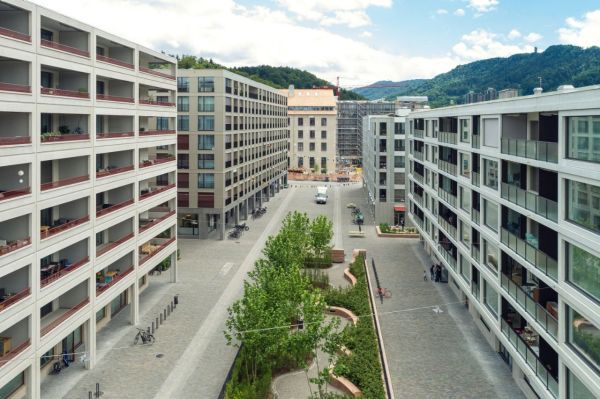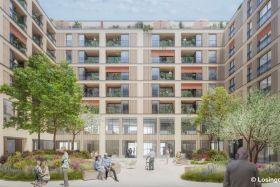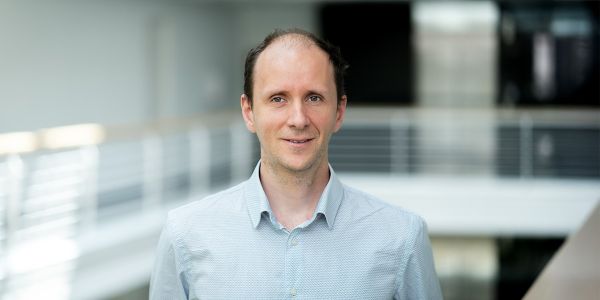- Living and working spaces for over 8,000 people
- 13,000 MWh/a energy for heating and hot water
- 5,300 MWh/a energy for cooling
- 500 kWp PV output power
- E-charging stations
- 2,400 tonnes of CO₂ saved per year
To the south of the city of Zurich, between the motorway and river Sihl, lies the former industrial area of Manegg. Instead of factories, residential and office buildings now characterise the area, which has become a separate district known as ‘Greencity.’ Real estate developer Losinger Marazzi AG was responsible for the Greencity concept. As a partner in the energy sector, we planned, financed and implemented a holistic solution for the entire energy infrastructure. This includes supplying all buildings with electricity, heating and cooling. We are also responsible for the telecommunications infrastructure and the charging infrastructure for electromobility. To date, a total of 24 charging stations have been installed in the underground car parks on site. As an energy service provider, we are also responsible for operating the energy supply as part of a long-term contract.
Green roofs
Our energy concept is based on the focus of Greencity as a 2,000-watt site. Ten buildings are equipped with photovoltaic systems with a total output of more than 500 kWp. When additional buildings are constructed, a further expansion of the photovoltaics is planned. The self-produced solar power not only supplies the site’s energy centre, but also the apartments in Greencity via an investment model. Greening ensures that the roof doesn’t get too hot in summer, allowing the modules to function efficiently at all times.
More and more properties
Four years after the first users moved into their apartments and offices, Greencity is largely complete. The last sector B6 (Vergé) is expected to be completed by early 2026. The Vergé building is the last development in the sustainable Greencity neighbourhood of Zurich, developed and implemented by Losinger Marazzi.

Wells and probes
Groundwater and geothermal energy used for heating and cooling are well-known and established renewable energy sources. What is innovative, however, is that the two systems are combined. ‘Greencity belongs partly to a geothermal energy area and partly to a groundwater area,’ explains the project manager David Füllemann. However, the use of thermal energy from groundwater is limited to 5,500 MWh per year. The geothermal energy therefore also had to be tapped in order to generate enough energy for the site. This means that, in addition to six groundwater wells, 215 geothermal probes, each 220 metres deep, provide heating in winter and cooling in summer.
Grids for heating and cooling
The primary source of energy is groundwater. It is collected via the wells and then heated to the required temperature level of 35 °C via four ammonia heat pumps with a total output of 5 MW at Greencity’s energy centre. The thermal energy is fed into the individual buildings via the district heating network, where it is used for space heating. The hot water, on the other hand, is heated up to 60 °C at almost 30 decentralised substations via a heat pump. For this process, we use the return flow from underfloor heating in summer, while in winter we use the waste heat from the buildings and heat from the surrounding area, groundwater and geothermal probes. The separate district cooling network is used to cool the buildings in summer.
Groundwater harmonises perfectly with the secondary energy source, geothermal energy. The heat generated in summer from the cooling supply can be used, for example, to regenerate the geothermal probes. The probes act as a seasonal heat store by reusing the thermal energy for the district heating network in the colder season.
Flexibility required
Having gained several years of operational experience, our project manager is satisfied with the energy concept. The challenge, he says, was to develop a concept that could tolerate deviations from the forecast, as these always occur in reality. ‘Some flexibility is needed for the system to be robust enough,’ explains Füllemann. This is also due to changes in the environment. One example of this is climate change, which tends to lead to warmer winters and hot summers. As a result of this development, it is foreseeable that the demand for cooling will increase in the future, while the demand for heating will probably decrease. ‘We will have to make sure that the geothermal probes don’t overheat in summer when a lot of thermal energy is recovered via the cooling process,’ says Füllemann, describing a potential effect. Various simulations were therefore carried out after the hot summer of 2018 in order to be well prepared for such extreme events.
Site monitoring and optimisation
The geothermal probes are constantly monitored using actual and target values.
The coronavirus pandemic, which had a noticeable impact on operations in 2020 and 2021, is another example of this. With people working from home for several months, occupancy in the office buildings fell sharply. As a result, less room cooling was required in the summer months, as fewer internal heat loads were generated by users. Our operations team still has no evaluations for summer operations. By contrast, winter operations were less affected by the pandemic and heating was largely supplied as normal.
Cooling instead of heating
A long-term project like Greencity brings together many exciting lessons learnt. From Füllemann’s point of view, the importance of cooling via free cooling has been an important finding. In the industry, the concept had long been underestimated and dismissed as a gimmick. ‘Our experience at Greencity shows that free cooling should be a central cornerstone of any energy concept these days.’ Füllemann is convinced that climate change will make it even more important in the future.
Various benefits
These examples show that operating an energy infrastructure solution is time-consuming and requires a great deal of expertise. In Greencity, we are responsible for the site’s entire heating, cooling and electricity network, as well as the energy systems, based on a long-term 30-year contracting agreement. The property owners benefit from our expertise and experience. Energy infrastructure solutions have been part of our core business for many years.







